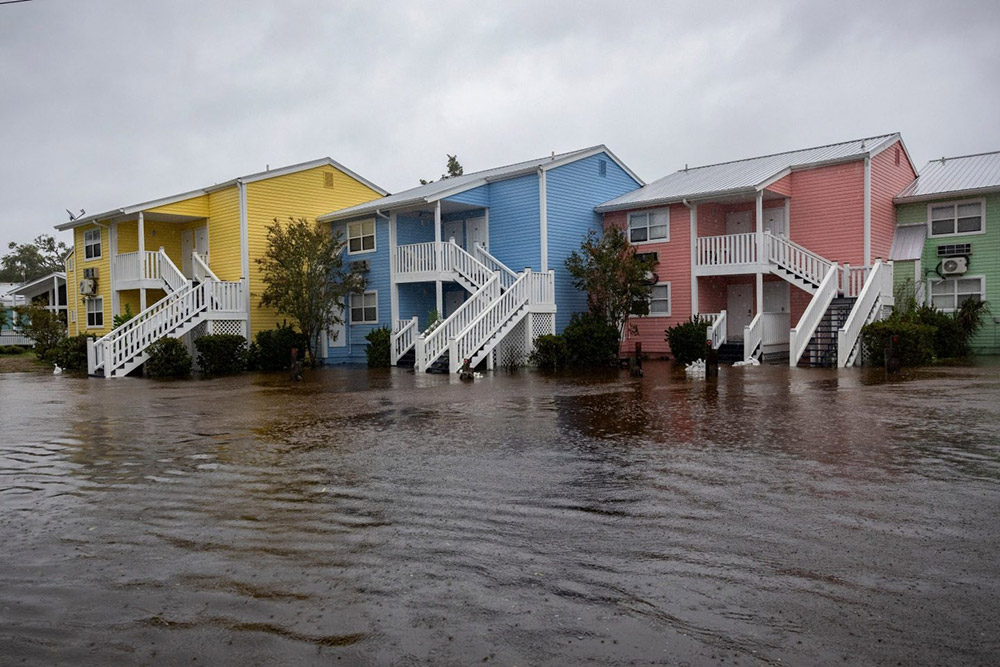
房地产市场呈现出一种风险极高的双头趋势。一方面,由于房屋位于恶劣天气区,或者因为存量住房陈旧,保险公司拒绝承保房产。另一方面,由于同样的风险,银行不给房屋发放抵押贷款。其结果是住房市场进一步两极分化——可以投保和抵押的传统房屋,以及只能以全现金和大幅折扣出售(如果还能卖得出去的话)的新兴房产。
美国消费者联合会(the Consumer Federation of America)今年发布的一份报告给出这样的结论:三年前,610万房主没有给房屋上保险,价值1.6万亿美元的无保险房屋面临风险。这是我们能掌握的最新的数据,自那以来的情况只会更糟。然而这样的房子仍然可以出售。美国数字新闻网站 Axios称:“无法投保的房屋仍然在房地产市场上交易。” 该出版物在报道中称,你不能为他们抵押贷款,但你可以全款购买,并可能获得大幅折扣。
我不必告诉你没有保险的财产有多大的风险。如果你是一位亿万富翁,只想要景色极佳的房子,而且钱多得用不尽,那么可能你不需要购买房屋保险。但对于居住在加利福尼亚州、佛罗里达州、得克萨斯州或其他易受恶劣天气影响地区的典型美国人来说,这并不是一个选项。通常,只有低价值的房屋和低收入家庭才不去购买房屋保险。如果他们负担不起迅速上涨的保费,或者根本找不到愿意承保的保险公司,他们可能会选择不投保。即便如此,加利福尼亚州和佛罗里达州等地设有自己的最后一道保险网,例如前者的公平计划(FAIR Plan)和后者的公民计划(Citizens)。
你需要知道的是,全美各地都在爆发保险危机,上述几个州尤甚。在加利福尼亚,财产保险公司正在限制他们承保的保单数量或拒绝承保新保单。在佛罗里达,好几个家庭保险公司已经逃离该州。保险危机使房主和购房者更难应对高昂的价格和抵押贷款利率。
房地产咨询公司CoreLogic的全球保险解决方案业务总裁加里特·格瑞(Garret Gray)曾告诉我,他位于洛杉矶峡谷的房子几乎无法投保。他说:“它的CoreLogic火灾评分非常糟糕。”在做出一些改变使房屋可投保之前,他几乎不再考虑买卖这个房子。问题是,有些人可能不会退出交易,而是试图从卖家那里获得更低的价格。
另一个例子来自迈阿密大学金融专业实践助理教授、该市业主杰森·达姆(Jason Damm)。他曾告诉我,有一年他给房子续保后,保费上涨了。然后保险公司通知他,该公司退出该州的业务,并取消他的保单。于是他的房子失去了保险,他也没有决定该怎么做,因为要想找到愿意承保的公司,成本很高,难度很大。“我的房子没买保险,这很危险,”达姆说。“我一直在寻找承保商。保费很贵,所以我还没决定该怎么办。这是一个大问题。我的意思是,我不知道该怎么办,应该试着去找一家承保商,还是干脆不买保险了。”
不仅是他。迈阿密的无保险房主比例最高,约为15%,而且该市的房屋价值丝毫没有下降。一直以来,这座城市极易受到恶劣天气影响,每年都会遭受数十亿美元的损失。然而人们似乎仍然在迈阿密买卖房屋,无论是否投保。(财富中文网)
译者:辜傲诗
房地产市场呈现出一种风险极高的双头趋势。一方面,由于房屋位于恶劣天气区,或者因为存量住房陈旧,保险公司拒绝承保房产。另一方面,由于同样的风险,银行不给房屋发放抵押贷款。其结果是住房市场进一步两极分化——可以投保和抵押的传统房屋,以及只能以全现金和大幅折扣出售(如果还能卖得出去的话)的新兴房产。
美国消费者联合会(the Consumer Federation of America)今年发布的一份报告给出这样的结论:三年前,610万房主没有给房屋上保险,价值1.6万亿美元的无保险房屋面临风险。这是我们能掌握的最新的数据,自那以来的情况只会更糟。然而这样的房子仍然可以出售。美国数字新闻网站 Axios称:“无法投保的房屋仍然在房地产市场上交易。” 该出版物在报道中称,你不能为他们抵押贷款,但你可以全款购买,并可能获得大幅折扣。
我不必告诉你没有保险的财产有多大的风险。如果你是一位亿万富翁,只想要景色极佳的房子,而且钱多得用不尽,那么可能你不需要购买房屋保险。但对于居住在加利福尼亚州、佛罗里达州、得克萨斯州或其他易受恶劣天气影响地区的典型美国人来说,这并不是一个选项。通常,只有低价值的房屋和低收入家庭才不去购买房屋保险。如果他们负担不起迅速上涨的保费,或者根本找不到愿意承保的保险公司,他们可能会选择不投保。即便如此,加利福尼亚州和佛罗里达州等地设有自己的最后一道保险网,例如前者的公平计划(FAIR Plan)和后者的公民计划(Citizens)。
你需要知道的是,全美各地都在爆发保险危机,上述几个州尤甚。在加利福尼亚,财产保险公司正在限制他们承保的保单数量或拒绝承保新保单。在佛罗里达,好几个家庭保险公司已经逃离该州。保险危机使房主和购房者更难应对高昂的价格和抵押贷款利率。
房地产咨询公司CoreLogic的全球保险解决方案业务总裁加里特·格瑞(Garret Gray)曾告诉我,他位于洛杉矶峡谷的房子几乎无法投保。他说:“它的CoreLogic火灾评分非常糟糕。”在做出一些改变使房屋可投保之前,他几乎不再考虑买卖这个房子。问题是,有些人可能不会退出交易,而是试图从卖家那里获得更低的价格。
另一个例子来自迈阿密大学金融专业实践助理教授、该市业主杰森·达姆(Jason Damm)。他曾告诉我,有一年他给房子续保后,保费上涨了。然后保险公司通知他,该公司退出该州的业务,并取消他的保单。于是他的房子失去了保险,他也没有决定该怎么做,因为要想找到愿意承保的公司,成本很高,难度很大。“我的房子没买保险,这很危险,”达姆说。“我一直在寻找承保商。保费很贵,所以我还没决定该怎么办。这是一个大问题。我的意思是,我不知道该怎么办,应该试着去找一家承保商,还是干脆不买保险了。”
不仅是他。迈阿密的无保险房主比例最高,约为15%,而且该市的房屋价值丝毫没有下降。一直以来,这座城市极易受到恶劣天气影响,每年都会遭受数十亿美元的损失。然而人们似乎仍然在迈阿密买卖房屋,无论是否投保。(财富中文网)
译者:辜傲诗
There’s an incredibly risky two-pronged trend in the housing market. Insurance companies are refusing to cover properties because they’re located in severe weather zones or because the housing stock is old. And banks won’t give you a mortgage because of the same risk. The outcome is a further divided housing market—traditional homes that can be insured and mortgaged and a burgeoning segment of properties that can only be sold for cash and at a deep discount, if at all.
An estimated $1.6 trillion in property value of uninsured homes was at risk three years ago and 6.1 million homeowners were uninsured, concluded a report published this year from the Consumer Federation of America. It’s only grown worse since then, even if that is the most recent data available. And yet, such homes can still sell. According to Axios, “uninsurable homes still change hands on the housing market.” You can’t take a mortgage out on them, but you can pay all-cash, and probably receive a steep discount, the publication reported.
I don’t have to tell you how much of a risk it is to have an uninsured property. It may be less so if you’re a billionaire who wants a stunning view and has cash to burn. But for typical Americans living in California, Florida, Texas, or other states vulnerable to severe weather, not so much. More often than not, these are low-valued homes and low-income households that go uninsured. They may choose to go without insurance if they can’t afford rapidly rising premiums or if they simply can’t find an insurer to cover them. Even so, places such as California and Florida have their own last resort forms of coverage, whether it be the FAIR Plan for the former and Citizens for the latter.
What you need to know is there’s an insurance crisis unraveling across the country, especially in those states mentioned above. In California, property insurers are capping the number of policies they write or refusing to write new ones. In Florida, multiple home insurers have fled the state. Insurance woes have made it much harder for homeowners and homebuyers dealing with skyhigh prices and mortgage rates.
The president of CoreLogic’s global insurance solutions business, Garret Gray, once told me his house in a Los Angeles canyon was nearly uninsurable. “It’s got a really bad CoreLogic fire score,” he said. He almost backed out of the deal before he made some changes to make the home insurable. The thing is, some people might not back out of the deal. Instead, they might attempt to get a better deal from the seller.
Then there’s Jason Damm, an assistant professor of professional practice of finance at the University of Miami and a landlord in the city. He once told me that after renewing his insurance earlier that year, his premium went up. That was before the insurer sent him a notice that it was pulling out of the state and his policy was canceled. At the time, he was without insurance and hadn’t decided what to do because of how costly and difficult it was to find coverage. “I don’t have insurance on the house, which is quite dangerous,” Damm previously said. “I’ve been looking. It’s very expensive, so I’m trying to decide what to do. It’s a huge problem. I mean, I don’t know what I’m going to do with it, whether I’m going to try and find a policy or just go without insurance.”
It’s not just him. Miami happens to have the highest share of uninsured homeowners, about 15% worth, and its home values haven’t fallen at all. All the while, the city is extremely vulnerable to climate related events, which costs the entire country billions of dollars a year. So it seems people are still buying and selling homes in Miami, insured or uninsured.






